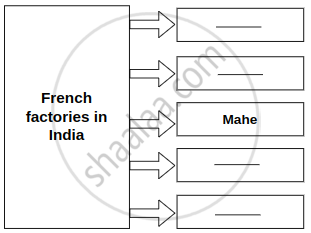Topics
Renaissance in Europe and Development of Science
European Colonialism
India and European Colonialism
Colonialism and the Marathas
India: Social and Religious Reforms
Indian Struggle Against Colonialism
- Struggle before 1857
- The Freedom Struggle of 1857
- Background of Founding the Indian National Congress
- Foundation of the Indian National Congress
- 'Moderates' and 'Extremists'
- Armed Revolutionaries in India
- Mahatma Gandhi: Non-violent Resistance Movement
- Indian National Army (Azad Hind Sena)
- 'Quit India' Movement of 1942
Decolonisation to Political Integration of India
World Wars and India
World : Decolonisation
Cold War
India Transformed - Part 1
India Transformed - Part 2
Notes
India and European Colonialism - French:
In 1664, ‘French East India Company’ (La Compagnie des Indes Orientalis) was established, with the initiative of Jean- Baptiste Colbert, the French finance minister to King Louis XIV. The company was given the authority to trade with eastern countries, to maintain army and navy and also exemption from taxes. The company was also given the authority to enter a war or treaty with the eastern rulers. In 1666, the company sent a diplomatic contingent to the court of Mughal Emperor Aurangzeb and obtained the permission to establish a factory in Surat. The first French factory in Surat was established in 1668. Then the factories at Pondicherry (Puducherry), Chandranagar, Mahe, Karikal and Machilipatnam were built. During this period the French were fighting with the Qutubshahi ruler and the Dutch. Pondicherry was the main centre of the French operations. It was ruled by the Nawab of Karnataka. The members of the Nawab’s family were fighting amongst themselves for the throne. The British and the French started intervening in the matter. It resulted in three battles between the British and the French from 1744 to 1763 C.E. These are known as ‘Carnatic Wars’. The Carnatic Wars were a series of military conflicts in the middle of the 18th century in India. The conflicts involved numerous nominally independent rulers and their vassals, struggles for succession and territory; and included a diplomatic and military struggle between the French East India Company and the British East India Company. They were mainly fought within the territories of Mughal India with the assistance of various fragmented polities loyal to the "Great Moghul". As a result of these military contests, the British East India Company established its dominance among the European trading companies within India. The French company was pushed to a corner and was confined primarily to Pondichéry. The East India Company's dominance eventually led to control by the British Company over most of India and eventually to the establishment of the British Raj.
In the 18th century, the coastal Carnatic region was a dependency of Hyderabad. Three Carnatic Wars were fought between 1744 and 1763.The French were defeated by the British in the third battle.
With the termination of the War of Austrian Succession in Europe, the First Carnatic War (1746-1748) also came to an end. In the Treaty of Aix-la-Chapelle (1748), Madras was given back to the British in exchange for the French fortress of Louisbourg in North America, which the British had captured. The war was principally notable in India as the first military experience of Robert Clive, who was taken prisoner at Madras but managed to escape, and who then participated in the defence of Cuddalore and the siege of Pondicherry.
The Second Carnatic war (1749-1754) ended with the Treaty of Pondicherry, signed in 1754, which recognised Muhammad Ali Khan Walajah as the Nawab of the Carnatic. Charles Godeheu replaced Dupleix, who died in poverty back in France.
The Third Carnatic War(1756-1763) spread beyond southern India and into Bengal where British forces captured the French settlement of Chandernagore (now Chandannagar) in 1757. However, the war was decided in the south, where the British successfully defended Madras, and Sir Eyre Coote decisively defeated the French, commanded by the comte de Lally at the Battle of Wandiwash in 1760. After Wandiwash, the French capital of Pondicherry fell to the British in 1761.
The war concluded with the signing of the Treaty of Paris in 1763, which returned Chandernagore and Pondichéry to France, and allowed the French to have "factories" (trading posts) in India but forbade French traders from administering them. The French agreed to support British client governments, thus ending French ambitions of an Indian empire and making the British the dominant foreign power in India.
With the defeat of the French, there was no European rival left in India for the British.

